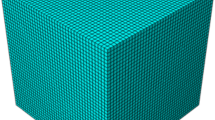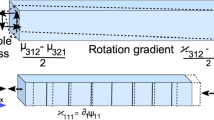Abstract
A dense closed cell foam is studied to determine which continuum theory of elasticity is applicable. Size effects inconsistent with classical elasticity are observed. The material exhibits a characteristic length scale considerably larger, by more than a factor 6, than the largest observable structure size. The Cosserat coupling number \(N\) is shown to be small, via measurements of size effects in square section bars, comparison with size effects in round section bars, and determination of warp of a square section bar in torsion. For this material, the couple stress theory is excluded and the modified couple stress theory is excluded. Theories that force constants to their thermodynamic limits do not apply to this foam. The role of other generalized continuum theories is considered.







Similar content being viewed by others
References
Cosserat, E., Cosserat, F.: Theorie des Corps Deformables. Hermann et Fils, Paris (1909)
Mindlin, R.D.: Stress functions for a Cosserat continuum. Int. J. Solids Struct. 1, 265–271 (1965)
Eringen, A.C.: Theory of micropolar elasticity. In: Liebowitz, H. (ed.) Fracture, vol. 1, pp. 621–729. Academic Press, New York (1968)
Gauthier, R.D., Jahsman, W.E.: A quest for micropolar elastic constants. J. Appl. Mech. 42, 369–374 (1975)
Krishna Reddy, G.V., Venkatasubramanian, N.K.: On the flexural rigidity of a micropolar elastic circular cylinder. J. Appl. Mech. 45, 429–431 (1978)
Lakes, R.S., Drugan, W.J.: Bending of a Cosserat elastic bar of square cross section—theory and experiment. J. Appl. Mech. 82(9), 091002 (2015) (8 pages)
Drugan, W.J., Lakes, R.S.: Torsion of a Cosserat elastic bar with square cross section: theory and experiment. Z. Angew. Math. Phys. 69(2), 24 (2018)
Mindlin, R.D.: Effect of couple stresses on stress concentrations. Exp. Mech. 3, 1–7 (1963)
Koiter, W.T.: Couple-Stresses in the theory of elasticity, Parts I and II. Proc. K. Ned. Akad. Wet. 67, 17–44 (1964)
Hadjesfandiari, A.R., Dargush, G.F.: Couple stress theory for solids. Int. J. Solids Struct. 48, 2496–2510 (2011)
Yang, F., Chong, A.C.M., Lam, D.C.C., Tong, P.: Couple stress based strain gradient theory for elasticity. Int. J. Solids Struct. 39, 2731–2743 (2002)
Neff, P., Jeong, J., Fischle, A.: Stable identification of linear isotropic Cosserat parameters: bounded stiffness in bending and torsion implies conformal invariance of curvature. Acta Mech. 211(3–4), 237–249 (2010)
Lakes, R.S.: Experimental microelasticity of two porous solids. Int. J. Solids Struct. 22, 55–63 (1986)
Rueger, Z., Lakes, R.S.: Experimental Cosserat elasticity in open cell polymer foam. Philos. Mag. 96, 93–111 (2016)
Rueger, Z., Lakes, R.S.: Cosserat elasticity of negative Poisson’s ratio foam: experiment. Smart Mater. Struct. 25, 054004 (2016), 8 pp.
Rueger, Z., Lakes, R.S.: Strong Cosserat elasticity in a transversely isotropic polymer lattice. Phys. Rev. Lett. 120, 065501 (2018)
Merkel, A., Tournat, V.: Experimental evidence of rotational elastic waves in granular phononic crystals. Phys. Rev. Lett. 107(22), 225502 (2011)
Spadoni, A., Ruzzene, M.: Elasto-static micropolar behavior of a chiral auxetic lattice. J. Mech. Phys. Solids 60, 156–171 (2012)
Beveridge, A.J., Wheel, M.A., Nash, D.H.: The micropolar elastic behaviour of model macroscopically heterogeneous materials. Int. J. Solids Struct. 50, 246–255 (2013)
General Plastics Company, 4910 Burlington Way, Tacoma, WA 98409, https://www.generalplastics.com/
Bigoni, D., Drugan, W.J.: Analytical derivation of Cosserat moduli via homogenization of heterogeneous elastic materials. J. Appl. Mech. 74, 741–753 (2007)
Gibson, L.J., Ashby, M.F.: Cellular Solids, 2nd edn. Pergamon, Oxford, Cambridge (1997)
Sokolnikoff, I.S.: Theory of Elasticity. Krieger, Malabar (1983)
Weiner, J.H.: Statistical Mechanics of Elasticity. Wiley, New York (1983)
Timoshenko, S.P.: History of Strength of Materials. Dover, New York (1983)
Drumheller, D.S., Sutherland, H.J.: A lattice model for stress wave propagation in composite materials. J. Appl. Mech. 40(1), 149–154 (1973)
Cowin, S.C., Nunziato, J.W.: Linear elastic materials with voids. J. Elast. 13, 125–147 (1983)
Hütter, G., Mülich, U., Kuna, M.: Micromorphic homogenizationn of a porous medium: elastic behavior and quasi-brittle damage. Contin. Mech. Thermodyn. 27, 1059–1072 (2015)
Hütter, G.: Application of a microstrain continuum to size effects in bending and torsion of foams. Int. J. Eng. Sci. 101, 81–91 (2016)
Anderson, W.B., Lakes, R.S.: Size effects due to Cosserat elasticity and surface damage in closed-cell polymethacrylimide foam. J. Mater. Sci. 29, 6413–6419 (1994)
Lakes, R.S., Gorman, D., Bonfield, W.: Holographic screening method for microelastic solids. J. Mater. Sci. 20, 2882–2888 (1985)
Eringen, A.C.: Theory of thermo-microstretch elastic solids. Int. J. Eng. Sci. 28(12), 1291–1301 (1990)
Mindlin, R.D.: Micro-structure in linear elasticity. Arch. Ration. Mech. Anal. 16, 51–78 (1964)
Eringen, A.C., Suhubi, E.S.: Nonlinear theory of simple micro-elastic solids—I. Int. J. Eng. Sci. 2(2), 189–203 (1964)
Kinra, V.K., Anand, A.: Wave propagation in a random particulate composite at long and short wavelengths. Int. J. Solids Struct. 18(5), 367–380 (1982)
Kinra, V.K., Ker, E.: An experimental investigation of pass bands and stop bands in two periodic particulate composites. Int. J. Solids Struct. 19(5), 393–410 (1983)
Acknowledgements
Partial support of the National Science Foundation under Grant CMMI-1361832 is gratefully acknowledged. We thank W.J. Drugan for application of the full analysis of [7] to interpret square section results.
Author information
Authors and Affiliations
Corresponding author
Additional information
Publisher’s Note
Springer Nature remains neutral with regard to jurisdictional claims in published maps and institutional affiliations.
Rights and permissions
About this article
Cite this article
Rueger, Z., Lakes, R.S. Experimental Study of Elastic Constants of a Dense Foam with Weak Cosserat Coupling. J Elast 137, 101–115 (2019). https://doi.org/10.1007/s10659-018-09714-8
Received:
Published:
Issue Date:
DOI: https://doi.org/10.1007/s10659-018-09714-8




